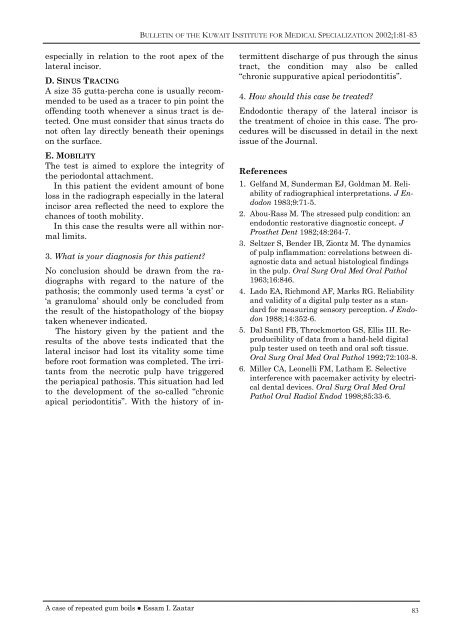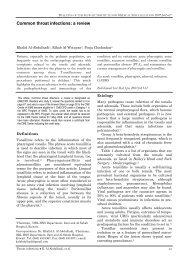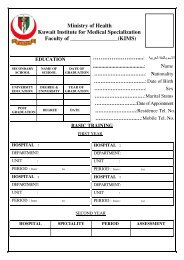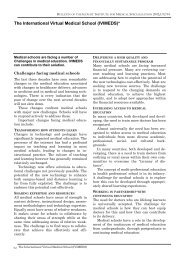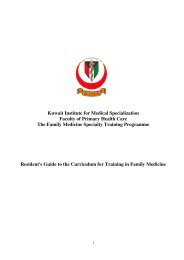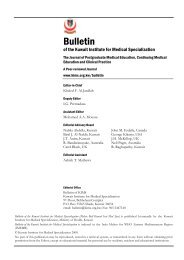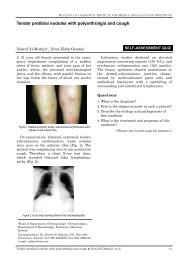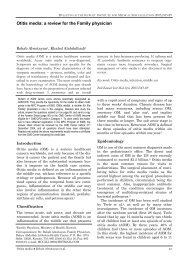A case of repeated gum boils with frequently yellowish foul ... - KIMS
A case of repeated gum boils with frequently yellowish foul ... - KIMS
A case of repeated gum boils with frequently yellowish foul ... - KIMS
Create successful ePaper yourself
Turn your PDF publications into a flip-book with our unique Google optimized e-Paper software.
BULLETIN OF THE KUWAIT INSTITUTE FOR MEDICAL SPECIALIZATION 2002;1:81-83<br />
especially in relation to the root apex <strong>of</strong> the<br />
lateral incisor.<br />
D. SINUS TRACING<br />
A size 35 gutta-percha cone is usually recommended<br />
to be used as a tracer to pin point the<br />
<strong>of</strong>fending tooth whenever a sinus tract is detected.<br />
One must consider that sinus tracts do<br />
not <strong>of</strong>ten lay directly beneath their openings<br />
on the surface.<br />
E. MOBILITY<br />
The test is aimed to explore the integrity <strong>of</strong><br />
the periodontal attachment.<br />
In this patient the evident amount <strong>of</strong> bone<br />
loss in the radiograph especially in the lateral<br />
incisor area reflected the need to explore the<br />
chances <strong>of</strong> tooth mobility.<br />
In this <strong>case</strong> the results were all <strong>with</strong>in normal<br />
limits.<br />
3. What is your diagnosis for this patient<br />
No conclusion should be drawn from the radiographs<br />
<strong>with</strong> regard to the nature <strong>of</strong> the<br />
pathosis; the commonly used terms ‘a cyst’ or<br />
‘a granuloma’ should only be concluded from<br />
the result <strong>of</strong> the histopathology <strong>of</strong> the biopsy<br />
taken whenever indicated.<br />
The history given by the patient and the<br />
results <strong>of</strong> the above tests indicated that the<br />
lateral incisor had lost its vitality some time<br />
before root formation was completed. The irritants<br />
from the necrotic pulp have triggered<br />
the periapical pathosis. This situation had led<br />
to the development <strong>of</strong> the so-called “chronic<br />
apical periodontitis”. With the history <strong>of</strong> intermittent<br />
discharge <strong>of</strong> pus through the sinus<br />
tract, the condition may also be called<br />
“chronic suppurative apical periodontitis”.<br />
4. How should this <strong>case</strong> be treated<br />
Endodontic therapy <strong>of</strong> the lateral incisor is<br />
the treatment <strong>of</strong> choice in this <strong>case</strong>. The procedures<br />
will be discussed in detail in the next<br />
issue <strong>of</strong> the Journal.<br />
References<br />
1. Gelfand M, Sunderman EJ, Goldman M. Reliability<br />
<strong>of</strong> radiographical interpretations. J Endodon<br />
1983;9:71-5.<br />
2. Abou-Rass M. The stressed pulp condition: an<br />
endodontic restorative diagnostic concept. J<br />
Prosthet Dent 1982;48:264-7.<br />
3. Seltzer S, Bender IB, Ziontz M. The dynamics<br />
<strong>of</strong> pulp inflammation: correlations between diagnostic<br />
data and actual histological findings<br />
in the pulp. Oral Surg Oral Med Oral Pathol<br />
1963;16:846.<br />
4. Lado EA, Richmond AF, Marks RG. Reliability<br />
and validity <strong>of</strong> a digital pulp tester as a standard<br />
for measuring sensory perception. J Endodon<br />
1988;14:352-6.<br />
5. Dal Santl FB, Throckmorton GS, Ellis III. Reproducibility<br />
<strong>of</strong> data from a hand-held digital<br />
pulp tester used on teeth and oral s<strong>of</strong>t tissue.<br />
Oral Surg Oral Med Oral Pathol 1992;72:103-8.<br />
6. Miller CA, Leonelli FM, Latham E. Selective<br />
interference <strong>with</strong> pacemaker activity by electrical<br />
dental devices. Oral Surg Oral Med Oral<br />
Pathol Oral Radiol Endod 1998;85:33-6.<br />
A <strong>case</strong> <strong>of</strong> <strong>repeated</strong> <strong>gum</strong> <strong>boils</strong> ● Essam I. Zaatar<br />
83


